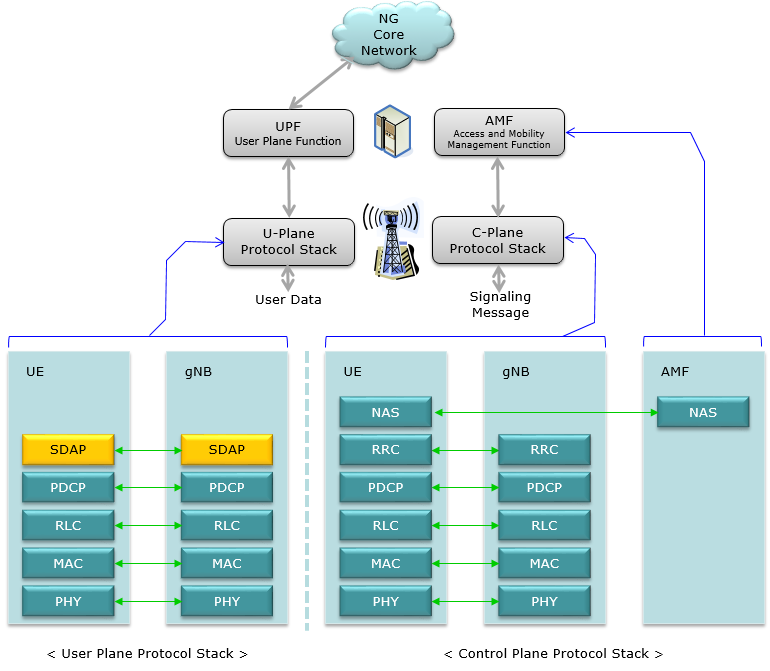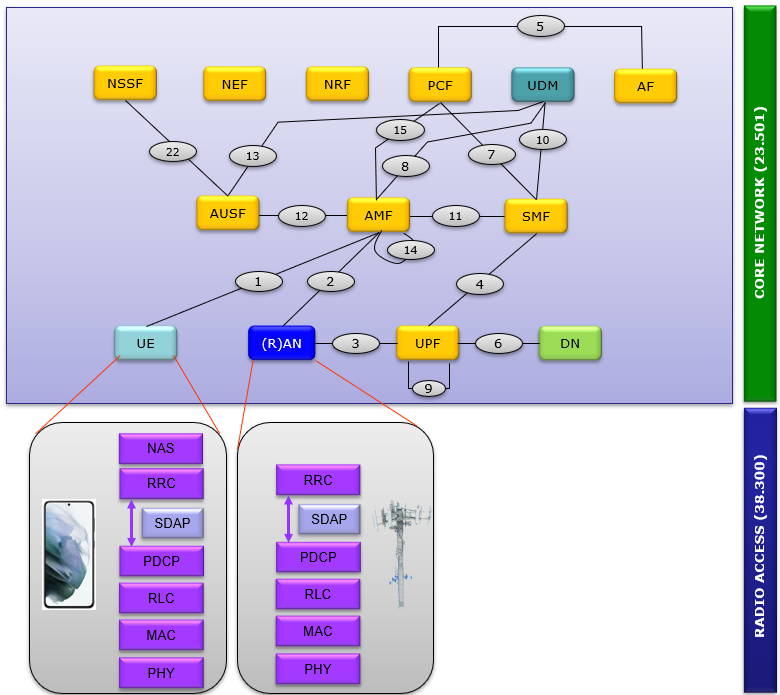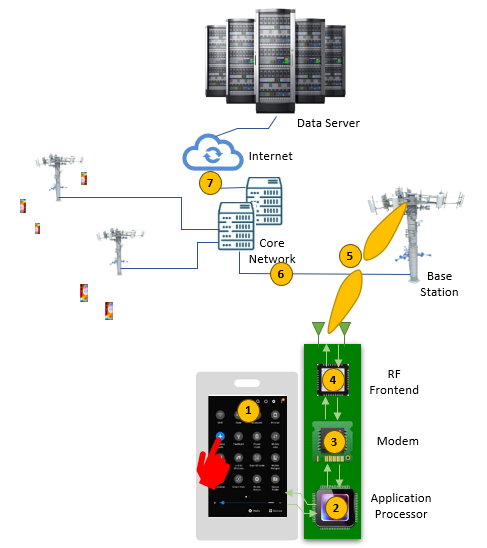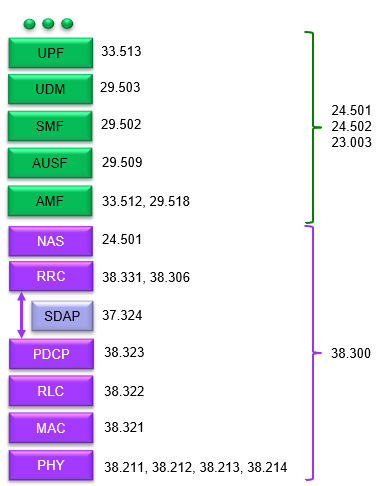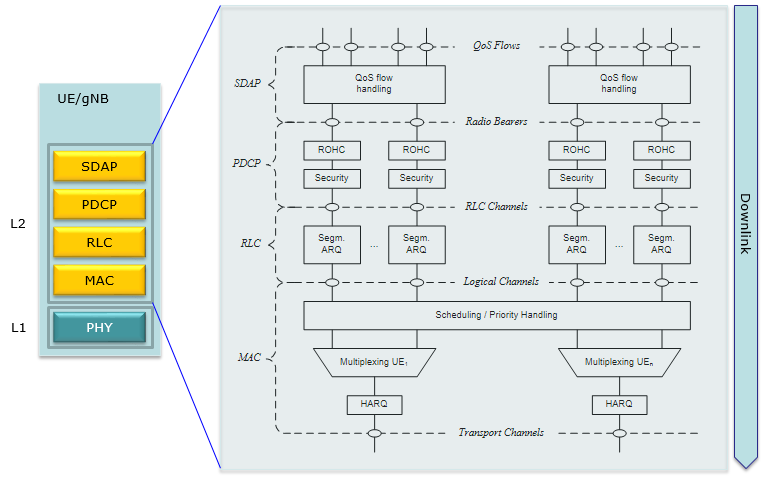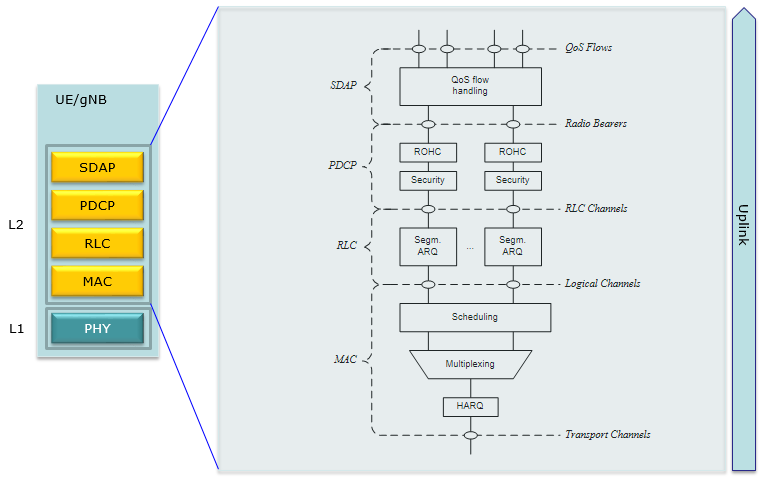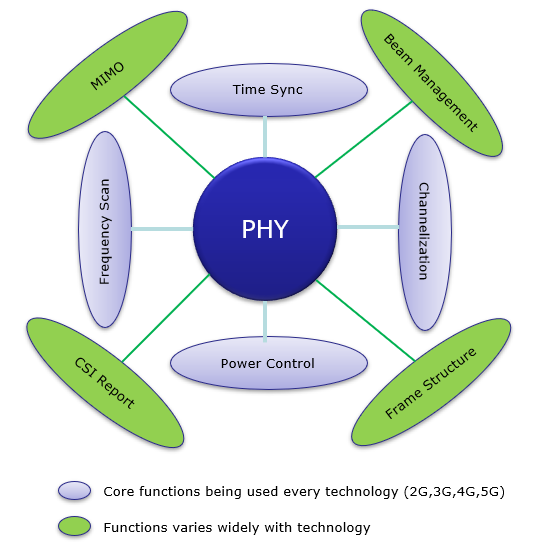|
|
|||||||||||||||||
|
5G/NR System Architecture is almost same as LTE System Architecture. If you are already familiar with LTE protocol stack or general concept of radio protocol stack, you would not need to spend too much time in reading this page. Just take a brief look at the various figures / diagrams shown in this page would be enough. If you are new to the concept of LTE/NR radio protocol stack, I would suggest you to go through this page whenever you have chance and try to form your own big picture. I would not describe much details on each component of the protocol stack in this page. It is too much to describe everything in a single page. The purpose of this page is to provide you with some big picture or intuitive understanding of the radio protocol stack. Most of the fundamental idea in this page comes from 3GPP 38.300 (Radio Access) and 23.501(NAS/Core Network).
High Level OverviewAs in LTE / WCDMA, NR radio protocol stack has two different stack depending on the type of data that is processed by the stack. If the data is Signaling message, it goes through the C-plane stack and if it is user data, it goes through U-Plane stack. Both U-Plane and C-Plane is made up of a common structure : PHY <-> MAC <-> RLC <-> PDCP, but the components sitting on top of PHY/MAC/RLC/PDCP gets different between C-Plane and U-Plane. In case of U-Plane, a layer called SDAP is sitting at the top of the radio stack and the SDP is connected to UPF (User Plane Function). In case of C-Plane, the two layers RRC and NAS are sitting at the top of the stack. NAS layer gets connected to AMF (Access and Mobility Management Function). What I've mentioned can be described in a block diagram as shown below.
Exploding the architecture into more detailed level, it can be illustrated as follows. The entire system is made up of roughly two part : Radio Accesss component and Core Network component. The main component of Radio Access parts are UE (e.g, mobile phone) and RAN (e.g, gNB, eNB etc) and the core network components are the remaining parts outside of UE and RAN.
Message Flow across the SystemThis is to show overall signal flow through the entire system with focus on radio access network. This image illustrates the high-level process of message flow in a 5G network, starting from the user's mobile device and moving through various network components until it reaches the data server. The arrows indicate the direction of the data flow, illustrating a complete cycle of communication from the user's device to the network and back. Click on the image or here and you can get the animated slideshow for this flow and descriptions of each steps. High level description of the signal flow depicted on this illustration is :
System Component and Specification MappingIf you are working in cellular communication industry or studying seriously in this area, you know you have to live with a huge set of specification documents called 3GPP TS(Test Specification). However you would often have difficulties in finding the appropriate documents for a specific topics you want to look into. I want to give you some high level mapping to each of the area of 5G system as summarized below. I think this would cover the fundamental parts of each components, but this is not the entire list. You may look into many of additional documents especially for core network components, but the specification listed here can definitely be a good starting point. This table outlines system components and their corresponding 3GPP specification numbers for 5G networks. I want you to use this table as a cheatsheet to map each network function with its technical specification, which is essential for developers, engineers, and researchers working with 5G technology to ensure compliance with international standards. The notes and references indicated by numbers in brackets ([1], [2], [3], etc.) are likely to provide additional context or details relevant to each component or specification. If you click on the numbers, it will take you to the note on sharetechnote with the detailed technical information.
Followings are the text version of this table with direct link to 3GPP document site
L2 Radio Stack OverviewNow let's look just one step further into the protocol stack. Take a look at the L2 (layer 2) structure of the NR U-Plane radio protocol. The structure of L2 downlink stack can be illustrated as shown below. Except the new layer called SDAP, you would notice that the overall structure is almost identical to LTE L2 structure. NR support carrier aggregation from the beginning, data for each carrier is processed separately for each carrier in SDAP, PDCP, RLC and multiplexed/scheduled in the common MAC layer. This is also same as LTE Rel 10 or higher.
Following is L2 structure of NR U-Plane Uplink radio protocol. Basic structure is same as downlink structure except that Uplink does not support carrier aggregation.
PHY Layer TopicsRegardless of the generations from 2G through 5G, there are some common features/functionalities even though the detailed mechanism and implementation are different. There are alsom some features/functionalities that are specific to a specific radio technology.
Each of these items are a huge topics and there are even more items not mentioned here. A very brief description of these items are :
Reference[1]
|
|||||||||||||||||
